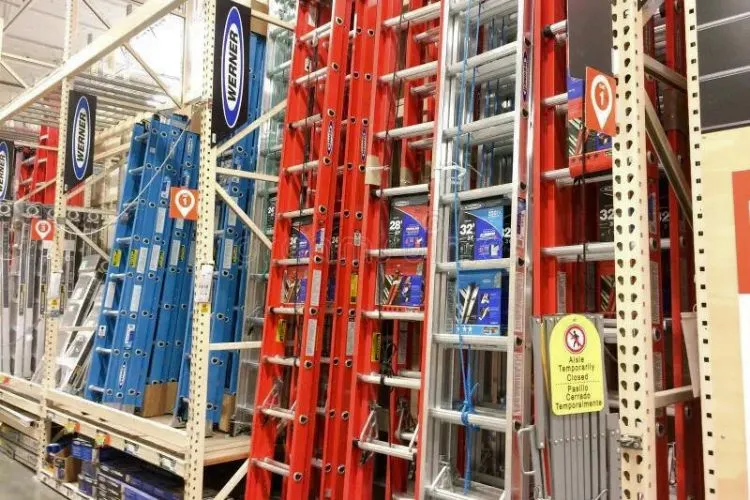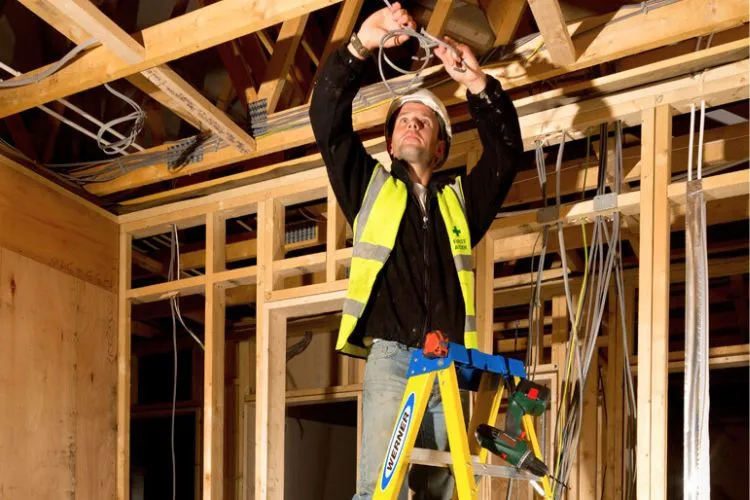Fiberglass ladders, widely used across industries for their durability and non-conductive properties, have long been the ladder of choice for electrical work.
But, do fiberglass ladders conduct electricity?
Well, in the world of ladders, whether a fiberglass ladder conducts electricity or not is paramount, especially when considering safety in various work environments.
This article aims to provide readers with a deeper understanding of the electrical conductivity of fiberglass ladders and how this feature contributes to their popularity in electrical safety.
By exploring the unique properties of fiberglass as a material, alongside a discussion of the ladder construction, we will shed light on the insulating features that make fiberglass ladders the trusted choice for professionals working with or around electricity.

Join us as we delve into the fascinating intricacies of this crucial ladder type and ensure that safety remains at the forefront of your ladder selection process.
Do fiberglass ladders conduct electricity?
No, fiberglass ladders do not conduct electricity. Fiberglass is a non-conductive material, which does not allow electricity to pass through it. This makes it a safer choice if you are working near power lines or other sources of electricity.
Unlike metal ladders, which are conductive and can cause electrical shocks or even electrocution if they come into contact with an electrical source, fiberglass ladders significantly reduce this risk.
However, despite fiberglass being non-conductive, safety should always come first. You should follow all recommended safety procedures and precautions when working near electricity.
It’s crucial to remember that while a fiberglass ladder is safer around electricity, no tool is 100% safe, and care should always be taken.
What kind of ladder is safe for electrical work?
🪜 Fiberglass Material
No, fiberglass ladders do not conduct electricity. Fiberglass is a composite material made of thin strands of glass fibers reinforced with resin. Unlike metal ladders (such as aluminum or steel), fiberglass ladders provide insulation from electric currents.

🪜 Safety Advantage
Fiberglass ladders offer a significant safety advantage when working near power lines or other sources of electricity. Metal ladders can cause electrical shocks, burns, or even electrocution if they come into contact with an electrical source.
A fiberglass ladder greatly reduces these risks as the non-conductive material prevents electricity from transferring to the user.
🪜 Additional Safety Precautions
Despite fiberglass being a non-conductive material, it is essential to exercise caution when working near electricity. Follow safety protocols and maintain a safe distance from power lines or other electrical sources. As a standard rule, never touch or approach electric wires with any object, including a fiberglass ladder.
🪜 Proper Ladder Maintenance
Keeping your fiberglass ladder in good condition is crucial to maintain its insulating properties. Inspect the ladder for any damage or cracks that may compromise the fiberglass material. Also, keep the ladder clean and free of dirt or debris, as some substances on the surface could affect its non-conductive properties.
Which ladder is unsafe near electricity?
🪜 Unsafe Ladder: Metal
A metal ladder is the most unsafe type of ladder to use near electricity. This includes ladders made of materials such as aluminum or steel. Metal is an excellent conductor of electricity, which can lead to dangerous or even fatal situations if the ladder comes into contact with a power source.
Touching a live wire or working too close to high voltage power lines with a metal ladder can result in severe electrical shock or electrocution.
🪜 Relatively Safe Ladder: Fiberglass
On the contrary, fiberglass ladders are a safer option when working around electrical sources. Fiberglass does not conduct electricity. Its insulating properties make it a more suitable choice when there’s a risk of exposure to electrical hazards.
However, no ladder or tool is entirely safe when working around electricity.
🪜 Safety Precautions
- Always maintain awareness of your surroundings, especially when working near power lines.
- It is recommended to keep a safe distance from power lines and never touch them with any part of the body or object, including a ladder.
- Ensure the ladder is in good condition and that no damage could compromise its insulating properties.
- Regularly check for cracks, splits or any signs of wear in the fiberglass.
- Keeping the ladder clean as dirt or other materials could carry a charge.
Which ladder material has the most electrical conductivity?
The ladder material with the most electrical conductivity is metal, particularly aluminum and steel ladders. Metals are excellent conductors of electricity, allowing electrical current to flow through them with very little resistance.
This makes metal ladders highly unsuitable and unsafe for use near electrical sources as they pose a significant risk of electrical shock or electrocution.

In contrast, fiberglass ladders are a safer option due to their insulating properties, as they do not conduct electricity.
When working near power lines or other electrical hazards, choosing a ladder made of a non-conductive material such as fiberglass is essential to minimize the risk of accidents.
However, safety measures and precautions should always be taken regardless of the ladder material, as no tool is entirely safe when working around electricity.
Always follow proper guidelines and exercise caution when working near electrical sources.
Conclusion:
In conclusion, fiberglass ladders do not conduct electricity, making them a safer option when working around power lines or other sources of electricity.
Unlike metal ladders, which can pose significant risks due to their conductive properties, fiberglass insulating characteristics help minimize the danger of electrical shock or electrocution.
However, it’s crucial to remember that safety extends beyond using non-conductive ladders. It’s paramount to adhere to all recommended safety guidelines and precautions when working near electrical sources.
Regular inspections and maintenance of the ladder are also necessary to ensure it remains in optimal condition and retains its insulating properties.
Always prioritize safety when working in environments with potential electrical hazards. Doing this and using the right tools like a fiberglass ladder can significantly reduce risks and maintain a safer working environment.


